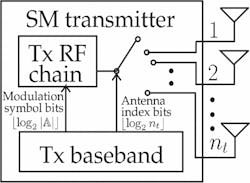Density is increasing for devices hungry for high-bandwidth data capacity. In response, solutions are being proposed for wireless systems that can handle all users. Multiple-input multiple-output (MIMO) wireless systems provide a good path for increasing the volume of data transferable to single- or multiple-user environments. Yet the traditional methods of multi-user MIMO, or massive MIMO, may suffer from signal-to-noise-ratio degradation at higher quadrature-amplitude-modulation (QAM) orders. As a result, researchers with the Indian Institute of Science in Bangalore, India—T. Lakshmi Narasimhan, P. Raviteia, and A. Chockalingam—are looking to use spatial-modulation (SM) MIMO. Their goal is to increase SNR using one RF signal chain.
The researchers use message passing and local search-based algorithms for SM-MIMO detection. This hybrid detection scheme initially uses the message-passing method. The results are then fed as the initial solution vector of the local search algorithm. This algorithm approach was found to have slightly enhanced performance over conventional algorithms in terms of loading factor and spectral efficiency based on QAM size.
The SM-MIMO technique performed better in SNR and bit-error-rate (BER) tests over other commonly used massive-MIMO algorithms. The key is that SM-MIMO requires a lower QAM alphabet order compared to massive MIMO at the same spectral efficiency, which is a function of the increased spatial streams per user. These factors lead to higher spatial interference with traditional massive-MIMO systems. See “Large-scale Multiuser SM-MIMO Versus Massive MIMO,” 2014 Information Theory and Applications Workshop (ITA), Feb. 2014, p. 1.

